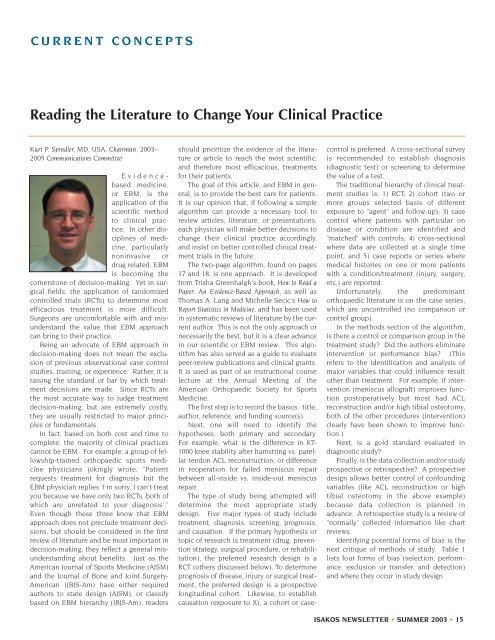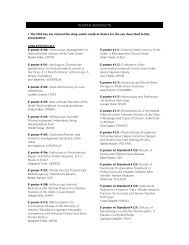N E W S L E T T E R N E W S L E T T E R - ISAKOS
N E W S L E T T E R N E W S L E T T E R - ISAKOS
N E W S L E T T E R N E W S L E T T E R - ISAKOS
You also want an ePaper? Increase the reach of your titles
YUMPU automatically turns print PDFs into web optimized ePapers that Google loves.
CURRENT CONCEPTS<br />
Reading the Literature to Change Your Clinical Practice<br />
Kurt P. Spindler, MD, USA, Chairman, 2003-<br />
2005 Communications Committee<br />
Evidencebased<br />
medicine,<br />
or EBM, is the<br />
application of the<br />
scientific method<br />
to clinical practice.<br />
In other disciplines<br />
of medicine,<br />
particularly<br />
noninvasive or<br />
drug related, EBM<br />
is becoming the<br />
cornerstone of decision-making. Yet in surgical<br />
fields, the application of randomized<br />
controlled trials (RCTs) to determine most<br />
efficacious treatment is more difficult.<br />
Surgeons are uncomfortable with and misunderstand<br />
the value that EBM approach<br />
can bring to their practice.<br />
Being an advocate of EBM approach in<br />
decision-making does not mean the exclusion<br />
of previous observational case control<br />
studies, training, or experience. Rather, it is<br />
raising the standard or bar by which treatment<br />
decisions are made. Since RCTs are<br />
the most accurate way to judge treatment<br />
decision-making, but are extremely costly,<br />
they are usually restricted to major principles<br />
or fundamentals.<br />
In fact, based on both cost and time to<br />
complete, the majority of clinical practices<br />
cannot be EBM. For example, a group of fellowship-trained<br />
orthopaedic sports medicine<br />
physicians jokingly wrote, "Patient<br />
requests treatment for diagnosis but the<br />
EBM physician replies 'I'm sorry, I can't treat<br />
you because we have only two RCTs, both of<br />
which are unrelated to your diagnosis'."<br />
Even though these three know that EBM<br />
approach does not preclude treatment decisions,<br />
but should be considered in the first<br />
review of literature and be most important in<br />
decision-making, they reflect a general misunderstanding<br />
about benefits. Just as the<br />
American Journal of Sports Medicine (AJSM)<br />
and the Journal of Bone and Joint Surgery-<br />
American (JBJS-Am) have either required<br />
authors to state design (AJSM), or classify<br />
based on EBM hierarchy (JBJS-Am), readers<br />
should prioritize the evidence of the literature<br />
or article to reach the most scientific,<br />
and therefore most efficacious, treatments<br />
for their patients.<br />
The goal of this article, and EBM in general,<br />
is to provide the best care for patients.<br />
It is our opinion that, if following a simple<br />
algorithm can provide a necessary tool to<br />
review articles, literature, or presentations,<br />
each physician will make better decisions to<br />
change their clinical practice accordingly,<br />
and insist on better controlled clinical treatment<br />
trials in the future.<br />
The two-page algorithm, found on pages<br />
17 and 18, is one approach. It is developed<br />
from Trisha Greenhalgh's book, How to Read a<br />
Paper: An Evidence-Based Approach, as well as<br />
Thomas A. Lang and Michelle Secic's How to<br />
Report Statistics in Medicine, and has been used<br />
in systematic reviews of literature by the current<br />
author. This is not the only approach or<br />
necessarily the best, but it is a clear advance<br />
in our scientific or EBM review. This algorithm<br />
has also served as a guide to evaluate<br />
peer-review publications and clinical grants.<br />
It is used as part of an instructional course<br />
lecture at the Annual Meeting of the<br />
American Orthopaedic Society for Sports<br />
Medicine.<br />
The first step is to record the basics: title,<br />
author, reference, and funding source(s).<br />
Next, one will need to identify the<br />
hypotheses, both primary and secondary.<br />
For example, what is the difference in KT-<br />
1000 knee stability after hamstring vs. patellar<br />
tendon ACL reconstruction, or difference<br />
in reoperation for failed meniscus repair<br />
between all-inside vs. inside-out meniscus<br />
repair.<br />
The type of study being attempted will<br />
determine the most appropriate study<br />
design. Five major types of study include<br />
treatment, diagnosis, screening, prognosis,<br />
and causation. If the primary hypothesis or<br />
topic of research is treatment (drug, prevention<br />
strategy, surgical procedure, or rehabilitation),<br />
the preferred research design is a<br />
RCT (others discussed below). To determine<br />
prognosis of disease, injury or surgical treatment,<br />
the preferred design is a prospective<br />
longitudinal cohort. Likewise, to establish<br />
causation (exposure to X), a cohort or case-<br />
control is preferred. A cross-sectional survey<br />
is recommended to establish diagnosis<br />
(diagnostic test) or screening to determine<br />
the value of a test.<br />
The traditional hierarchy of clinical treatment<br />
studies is: 1) RCT; 2) cohort (two or<br />
more groups selected basis of different<br />
exposure to "agent" and follow-up); 3) case<br />
control where patients with particular on<br />
disease or condition are identified and<br />
"matched" with controls; 4) cross-sectional<br />
where data are collected at a single time<br />
point; and 5) case reports or series where<br />
medical histories on one or more patients<br />
with a condition/treatment (injury, surgery,<br />
etc.) are reported.<br />
Unfortunately, the predominant<br />
orthopaedic literature is on the case series,<br />
which are uncontrolled (no comparison or<br />
control group).<br />
In the methods section of the algorithm,<br />
is there a control or comparison group in the<br />
treatment study? Did the authors eliminate<br />
intervention or performance bias? (This<br />
refers to the identification and analysis of<br />
major variables that could influence result<br />
other than treatment. For example, if intervention<br />
(meniscus allograft) improves function<br />
postoperatively but most had ACL<br />
reconstruction and/or high tibial osteotomy,<br />
both of the other procedures (intervention)<br />
clearly have been shown to improve function.)<br />
Next, is a gold standard evaluated in<br />
diagnostic study?<br />
Finally, is the data collection and/or study<br />
prospective or retrospective? A prospective<br />
design allows better control of confounding<br />
variables (like ACL reconstruction or high<br />
tibial osteotomy in the above example)<br />
because data collection is planned in<br />
advance. A retrospective study is a review of<br />
"normally" collected information like chart<br />
reviews.<br />
Identifying potential forms of bias is the<br />
next critique of methods of study. Table 1<br />
lists four forms of bias (selection, performance,<br />
exclusion or transfer, and detection)<br />
and where they occur in study design.<br />
<strong>ISAKOS</strong> NEWSLETTER • SUMMER 2003 • 15

















